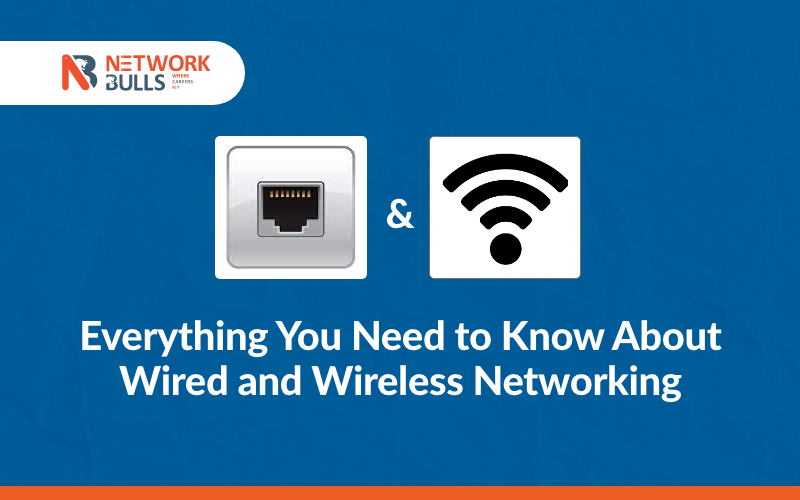Everything You Need to Know About Wired and Wireless Networking

Summary: In this article, we’ll try to understand what’s the basic difference between wired and wireless networking. As a networking professional, you must know it.
Everything You Need to Know About Wired and Wireless Networking
In networking, both wired and wireless modes are used for internet facilitation. While cables and wires are used in wired networking, radio waves are used in wireless networking.
In other words, a wired network denotes the use of a physical medium connected through cables and wires which can be made of copper, twisted pairs, or fiber optic. In the case of wireless mode, you can use electromagnetic waves or infrared waves for connectivity.
You can use wired technology in networking to provide high-security bandwidth for each user. It is marked by such features as high reliability and low delay in the transmission of data packets. You are using Ethernet to connect devices like routers, switches, and servers to each other and to the internet.
If you are using wireless connectivity, you are applying radio waves and using no cable or Ethernet but your wireless devices do have antennas for connectivity and communication.
Differences Between Wired and Wireless Networking
In networking, both the wired and wireless modes are deployed. Both are useful for connectivity.
However, you can find some differences between these two types of deployments. They are explained below:
-
Wired connectivity is more expensive to deploy than the wireless Installation
-
Wired connectivity is Ethernet connectivity whereas wireless connectivity is done through radio waves to connect devices like Wi-Fi or Bluetooth.
-
Wired installation facilitates faster transmission speed but wireless is comparatively slow in transmission speed.
-
In a wired regime, all devices are hard-wired which takes time but in a wireless deployment, you don’t have to do this. As a result, the installation and deployment of a wireless system is quick.
-
A wired network requires physical configuration but it is not required in wireless deployment.
-
The rate of data loss is very low in a wired system but it is high in a wireless network.
Method of Deployment of Wireless and Wired Networks
You use different methods to create your network using wired systems and wireless modes. These systems in both networking types are described below:
Wireless Network
You can follow three types of methods to deploy a wireless network:
- Centralized Deployment: This type of deployment can be used for a centralized network suited mostly for networks that are nearby like a building.
- Converged Deployment: Under this type of networking, the deployment can be done for a small school or college campus, or a branch office. It converges wired and wireless on one network device—an access switch—and performs the dual role of both switch and wireless controller.
- Cloud-Based Deployment: The cloud is used for this type of deployment for the network devices deployed on-premises at various places or locations. The Cisco Meraki cloud-managed devices can be used for this type of network.
Wired Networks
To deploy a wired network, you have to take the following four usual technological methods or routes:
-
Use cables (you can use different sorts of cables): cables can be Shielded, copper-based, or twisted-pair cable.
-
Coaxial. Copper-based coaxial cable.
-
Ethernet. Unshielded, copper-based, twisted-pair cable.
-
Fiber optic. Glass or plastic-based fiber-optic cable.
The global market size of networking is widening fast. This upward curve in networking market size has been made possible by the application of both wired and wireless systems by almost all corporate companies, government departments, academic institutions, and sales companies. The latest research report published by Business Wire says the global wireless connectivity market size reached US$ 107.5 billion in 2022 and is likely to reach US$ 233.5 billion by 2028. The CAGR during the 2022-2028 period is likely to be 13.8%.
In Conclusion
If you are using a PC, desktop, laptop, smartphone, or tablet access point, you need to use either wired or wireless networks. Without either of the deployments, you cannot transmit or send your data packets or information between devices.
The latest technology has made it possible to integrate wired and wireless deployments for networking. This is a major major advantage for internet users. By following some steps, you can integrate both systems to reap greater benefits. Your first step for integration is to create a layout or a network design.
Your second step would be to install and connect your network devices and configure your routers and switches. Thirdly, you have to set up and test your network settings like creating your network name, enabling your security protocol, and verifying your network connectivity.
FAQ:
Q1. What is wired networking?
Ans: Wired networking refers to the use of physical cables, such as Ethernet cables, to connect devices to a network.
Q2. What is wireless networking?
Ans: Wireless networking refers to the use of radio waves to connect devices to a network without the need for physical cables.
Q3. What are some common types of wired network connections?
Ans: Common types of wired network connections include Ethernet, fiber optic, and powerline networking.
Q4. What are some common types of wireless network connections?
Ans: Common types of wireless network connections include Wi-Fi, Bluetooth, and cellular networks.
Q5. Can wired and wireless networks be used together?
Ans: Yes, it is possible to combine wired and wireless networking technologies to create a hybrid network that offers the best of both worlds.
- RECOMMENDED POSTS
-
Trending (0)

-
Network Bulls Placements (53)

-
CCIE (101)

-
CCNP (32)

-
CCNA (40)

-
Awards (14)

-
Network Bulls Reviews (53)

-
Informational Articles (74)

-
Technical Articles (26)

-
CCIE Success Stories (40)

-
Summer Training Courses (5)

-
CCIE Security Version 5 (34)

-
CCIE Data Center (19)

-
MCSE (3)

-
Industrial Training (10)

-
Microsoft Certification (3)

-
Ask NB (7)

-
Network Bulls Offers (6)

-
Best Institute for CCIE Training in India (118)

-
CCIE Training Courses (78)

-
DHCP (2)

-
Webinars (6)

-
Training (128)





















